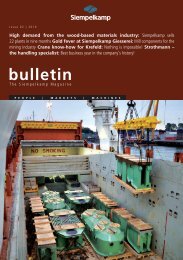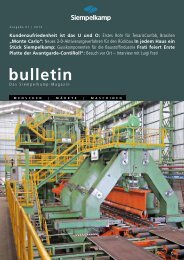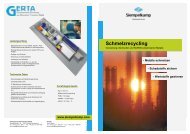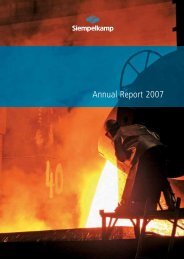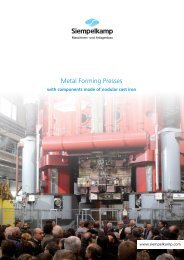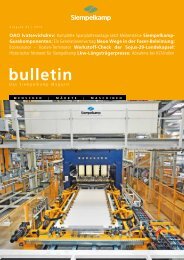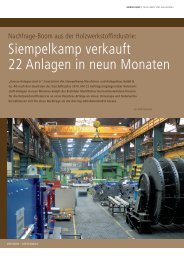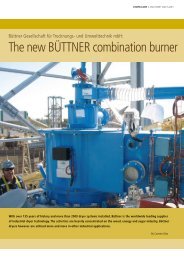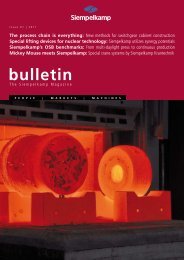OAO Ivatsevichdrev - Siempelkamp
OAO Ivatsevichdrev - Siempelkamp
OAO Ivatsevichdrev - Siempelkamp
You also want an ePaper? Increase the reach of your titles
YUMPU automatically turns print PDFs into web optimized ePapers that Google loves.
SIeMpelkAMp | nUCLeAR teCHnoLoGy 46 47<br />
Has SPG done any other exceptional tests?<br />
Dr. Peter Seliger: We have dedicated ourselves to a whole series<br />
of similarly illustrious projects. Particularly impressive, for example,<br />
was the endoscopic investigation of the sarcophagus of King<br />
John of Saxony (1801–1873). The X-ray examination of gold<br />
found in archaeological digs in Central Asia was also an exciting<br />
task.<br />
Johannes Seichter: Another exceptional job was attaching<br />
resistance strain gauges to the teeth and tooth implants of<br />
military pilots, to measure the involuntary biting forces, e.g.<br />
during nose dives.<br />
Dr. Peter Seliger: Not forgetting the non-destructive material<br />
testing on the wheel steamer “Diesbar,” which went on its virgin<br />
voyage down the Elbe in 1884. The Saxon Elbe wheel steamer<br />
fleet is the oldest and largest still in service anywhere in the<br />
world!<br />
So there is no shortage of extravagant projects for you to<br />
work on. Do you still have a “dream investigation” you<br />
would like to add to this collection?<br />
Dr. Peter Seliger: Absolutely! Right at the top of my list is the<br />
“Blue Wonder” of Dresden, one of the oldest riveted, self-<br />
supporting bridges. It was built between 1891 and 1893, so in<br />
terms of age, it is hard on the heels of the Eiffel Tower (Paris),<br />
which started construction in 1887.<br />
What would the challenge be there?<br />
Dr. Peter Seliger: The steel grades used in this bridge come<br />
from the tail end of the 19 th century. From an engineering<br />
perspective, the interesting thing is that the entire bridge is<br />
riveted, and supports itself over the entire breadth of the Elbe<br />
river. It certainly would be exciting to test the materials …<br />
Then we hope you get commissioned to do so, and thank<br />
you very much for the interview!<br />
In the cockpit of the Soyuz: steering units of the capsule, breathing air<br />
system etc – in most confined space, operated analogically<br />
SPG in Dresden – the specialist for extraordinary inspections<br />
Dresden Museum of Military History<br />
After seven years of restoration and rebuilding work, the Dresden<br />
Museum of Military History was ceremonially reopened on october<br />
14, 2011 by the Minister of Defence, Dr. thomas de Maizière.<br />
With over 10,500 exhibits in the permanent exhibition, over a<br />
total area of 19,000 m², the museum is one of the largest and<br />
most modern military history museums in europe.<br />
of particular note is the newly designed façade of the museum,<br />
created by star architect Daniel Libeskind. A giant, V-shaped<br />
wedge made from reinforced concrete and stainless steel cuts<br />
through the symmetrical old structure of the Royal saxon Army’s<br />
arsenal, which was built in the classical style between 1873 and<br />
1877. A successful union of history and the modern era.<br />
Amongst the top exhibits, also much sought-after by other<br />
museums, is without a doubt the soyuz 29 landing capsule.<br />
since 2011 it has been on display in the Libeskind wedge, at a<br />
height of about 10 m. It hangs there at precisely the same angle<br />
as it re-entered the earth’s atmosphere.





